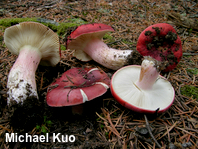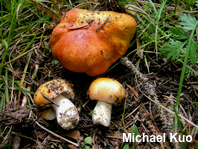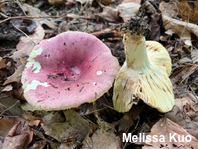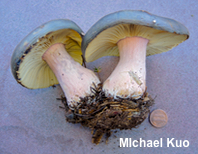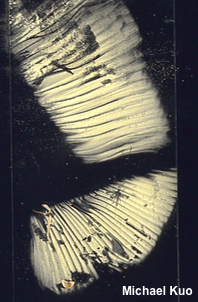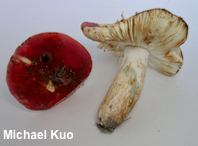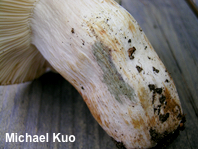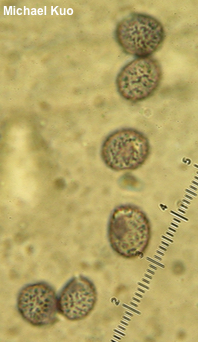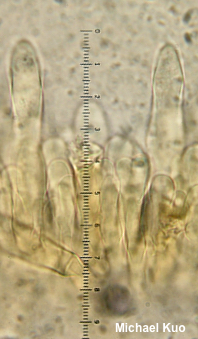
[ Basidiomycota > Russulales > Russulaceae . . . ]
North American Shrimp Russulas
by Michael Kuo, 3 October 2025
Often called the "shrimp russulas," these russulas have a characteristic odor, strongly reminiscent of shrimp or fish. If my experience is indicative, the odor smells faintly like fish at first, and becomes more and more "shrimpish" with maturity. Keep a specimen in the house for a few days (or dry it for later study), and you'd swear you were on the shrimp boat set of Forrest Gump. Aside from the odor, other distinguishing features for the shrimp russulas include: yellow-brown to brown staining on the stem, flesh, and gills; a dull yellow spore print; and a green reaction to iron salts on the stem surface and flesh.
Your North American field guide probably treats "Russula xerampelina," a European species described from Germany (Schaeffer 1770) before the American Revolution. However, since the 18th century many shrimp russulas have been described as different from xerampelina, in Europe and elsewhere—and recent publications have begun to address the situation on our continent, resulting in clarified, DNA-supported concepts for species named by North American mycologists long ago (e.g. Gertie Burlingham, Chuck Peck, Willy Murrill) along with newly described species, bringing the total number of North American shrimp russulas up to the two dozen range.
But there are plenty more shrimp russulas waiting to be "discovered" on our continent. For one thing, most of the recent species were described by Europeans on the basis of mycotouristic collections they made while visiting North America. The sample size is so small, in other words, that it would be silly to declare the project finished; there are so many diverse ecosystems, from the ice water border between Alaska and Russia to the dry rolling hills of eastern Kansas to the jungles and volcanic cloud forests at the Mexican border with Guatemala.
On the other hand, based on the most recent published phylogeny of the shrimp russulas (Noffsinger et al. 2024), a reasonable argument could be made for naming only three shrimp russulas (xerampelina, clavipes, and graveolens) from Europe and North America, based on the major groupings of phylogenetic species. To be clear the authors did not take the three-species route, and I have not done so, either. But doing so would have several benefits, including better communication about how the organisms have evolved and are related, and making identification easier, since the identification key might look something like this:
| 1. | Associated with conifers. | Russula xerampelina |
| 1. | Associated with hardwoods. | 2 |
| 2. | Associated with willows or birches, primarily in boreal and montane ecosystems. | Russula clavipes |
| 2. | Associated with oaks, beeches, and other temperate hardwoods. | Russula graveolens |
But the 3-species approach does fail to express some diversity—in distribution, DNA, and, to a degree, physical features—among the shrimp russulas. The problem is, identifying more than three shrimp russulas without DNA sequencing is more of an art than a science, despite the suspect claims made by some authors that painstaking microscopic analysis of the pileipellis elements near the edge of the cap will save your day (it won't). Cap colors are notoriously variable in this group of mushrooms; for example Russula olympiana is usually a purple mushroom but is often red—and yellowish or brown specimens are not infrequently encountered. Whether or not the stem is flushed with red to pink is not an entirely consistent identification feature, either. Nor is the extent of the brown staining, the strength of the shrimp odor, the extent to which the skin on the cap is easily peeled away, or the precise shade of yellow manifested in the spore print. Microscopically, the spores are similar among the shrimp russulas, although some differences in overall proportions and density of sporal ornamentation may be informative. The cystidia are similar. The pileipellis elements are similar, more likely (in my humble opinion) manifesting differences resulting from environmental conditions, maturation stages, and specimen selection than from speciation.
Thus shrimp russula identification without sequencing is a best-guess scenario, taking into consideration a bunch of admittedly variable features and hoping that they lead to accuracy. The key below represents this approach, treating 21 DNA-defined North American shrimp russulas. I have thrown in one or two putative "species" from my collections that do not appear to line up well on the basis of physical features, but these may, of course, merely represent color variants of the other species.
Key to 23 North American Shrimp Russulas 
| 1. | Associated with conifers. | 2 |
| 1. | Associated with hardwoods. | 17 |
| 2. | Fresh, unfaded cap orange. | 3 |
| 3. | Associated with high-elevation conifers in the southern Rocky Mountains. | |
| 4. | Fresh cap not bright red (but possibly purple-red or brownish red). | 8 |
| 5. | Distributed in the western United States or in montane Mexico; stem usually red to pink. | 6 |
| 5. | Distributed east of the Rocky Mountains; stem not red, but possibly flushed slightly pink. | 7 |
| 6. | Described from montane northern Mexico in association with Arizona pine and Chihuahua spruce. | Russula madrensis |
| 6. | Described from western North America (from Colorado to the Pacific Northwest) in association with various conifers. | |
| 7. | Described from Vermont in potential association with unspecified spruce and beech; stem white or with "a trace of pink." (Note: This species is almost certainly associated with hardwoods but I've placed it with conifers as well because spruce is mentioned with beech in the original description.) | |
| 7. | Described from Florida in association with longleaf pine and well documented from the Gulf Coast states under 3-needle pines; stem white. | Russula levyana |
| 8. | Fresh cap brown, yellow, yellow-green, or green overall. | 9 |
| 8. | Fresh cap a shade of purple. | 14 |
| 9. | Found in the Pacific Northwest. | 10 |
| 9. | Not found in the Pacific Northwest. | 11 |
| 10. | Described from Washington (Mt. Rainier) in association with unspecified conifers and collected in conifer forests throughout the Pacific Northwest; cap brown, or with yellowish to olive hues. | Russula viridofusca |
| 10. | Eastern North American species "discovered" in the Pacific Northwest through DNA sequencing and published as present without thorough morphological description of the sequenced specimens; cap said to be brown with a dark brown center (thus differing from the green to purple cap of the species as originally described). | "Russula serissima" |
| 12. | Found east of the Rocky Mountains. | Russula serissima |
| 13. | Described from southern Mexico in association with Ocote pine and Montezuma pine; cap yellowish. | Russula flavobrunnescens |
| 13. | Described from Florida in association with slash pine, possibly to be expected throughout the southeastern United States under 2- and 3-needle pines; cap "yellow with a white margin." | Russula ochrifloridana |
| 14. | Described from montane southern Mexico in association with 5-needle pines (Montezuma pine and Hartweg's pine). | Russula sancti-pauli |
| 14. | Distributed in the United States and Canada. | 15 |
| 15. | Distributed in western North America from Colorado to the Pacific Northwest; stem pink. | |
| 15. | Distributed east of the Rocky Mountains; stem white. | 16 |
| 16. | Brown staining of flesh and gills pronounced. (Note: This species is probably associated with hardwoods but I've placed it with conifers as well because documentation is insufficient.) | |
| 16. | Brown staining faint or apparent only on drying. | Russula serissima |
| 17. | Associated with alpine willows in western North America. | 18 |
| 17. | Associated with other hardwoods; distribution varying. | 19 |
| 18. | Spore print white to cream-colored; spore ornamentation of "moderately distant" warts and spines with occasional connectors. | Russula neopascua |
| 18. | Spore print dark cream to pale yellow; spore ornamentation of densely packed warts and spines with frequent connectors. | Russula subrubens |
| 19. | Associated with birches. | 20 |
| 19. | Associated with beech or oak. | 21 |
| 20. | Described from Vermont in association with gray birch. | Russula pseudoolivascens squalens |
| 20. | European species documented in North America from Alaska. | Russula clavipes |
| 21. | Described from southern California "in an open oak savannah"; cap yellowish to yellowish-brownish. | Russula grundii |
| 21. | Distributed east of the Rocky Mountains in association with various trees. | 22 |
| 22. | Described from Texas in association with various bottomland oaks and hickories; pileocystidia inflated up to 14 µm wide. | Russula texensis |
| 22. | Distributed in eastern North America outside of Texas; pileocystidia not inflated, up to 8 µm wide. | 23 |
| 23. | Described from Florida "under an oak"; cap pinkish red to purple; brown staining faint, possibly only manifesting when specimens are dried. | Russula obscuriformis |
| 23. | Variously distributed; associated with various hardwoods; cap color varying; brown staining moderate to strong. | 24 |
| 24. | Cap color variable (red, brownish red, purple-red, purple-brown, brown, brownish yellow); European species "discovered" under oaks in the Appalachians through DNA sequencing and published as present without morphological description of the sequenced specimens. | Russula graveolens |
| 24. | What am I supposed to do with that? Not helpful. Move along, please. | 25 |
| 25. | There's a gun to your head. Yes, it may be hard to decide. But decide you must. Either the cap, with a gun to your head, is red . . . | |
References
Adamčik, S. & B. Buyck (2010). Re-instatement of Russula levyana Murrill as a good and distinct American species of Russula section Xerampelinae. Cryptogamie, Mycologie 31: 119–135.
Adamčik, S., D. Mitchell & B. Buyck (2010). Russula ochrifloridana sp. nov., a new yellowish fishy Russula from Florida and its comparison with R. grundii. Cryptogamie, Mycologie 31: 363–372.
Adamčik, S. & B. Buyck (2011). The species of Russula subsection Xerampelinae described by C. H. Peck and Miss G. S. Burlingham. Cryptogamie, Mycologie 32: 63–81. Note: What kind of unexamined, unconscious sexism requires the compulsive iteration of "Miss" for Burlingham? Seriously.
Adamčik, S. & 30 coauthors (2015). Fungal biodiversity profiles 1–10. Cryptogamie, Mycologie 36: 121–166.
Adamčik, S. & 26 coauthors (2019). The quest for a globally comprehensible Russula language. Fungal Diversity 99: 369–349.
Buyck, B., S. Adamcik & D. P. Lewis (2008). Russula section Xerampelinae in Texas. Cryptogamie, Mycologie 29: 121–128.
Buyck, B. & S. Adamčik (2013). The Russula xerampelina complex (Russulales, Agaricomycotina) in North America. Scripta Botanica Belgica 51: 117–131.
Fatto, R. M. (1998). A study of selected Murrill's russulas. Mycotaxon 69: 487–502.
Knudsen, H., J. Ruotsalainen & J. Vauras (2018). Russula Pers. In Knudsen, H. & J. Vesterholt, eds. (2008). Funga Nordica: Agaricoid, boletoid and cyphelloid genera. Copenhagen: Nordsvamp. 144–186.
Kränzlin, F. (2005). Fungi of Switzerland: A contribution to the knowledge of the fungal flora of Switzerland. Volume 6 Russulaceae. Transl. Walters, V. L. & Walters, J. F. Lucern: Verlag Mykologia. 317 pp.
Læssøe, T. L. & J. H. Petersen (2019). Fungi of Temperature Europe (in 2 volumes). Princeton, NJ: Princeton University Press. 1715 pp.
Noffsinger, C. & C. L. Cripps (2021). Systematic analysis of Russula in the North American Rocky Mountain alpine zone. Mycologia 113: 1278–1315.
Noffsinger, C. R. & 12 coauthors (2024). Three new species in Russula subsection Xerampelinae supported by genealogical and phenotypic coherence. Mycologia 116: 322–349.
This site contains no information about the edibility or toxicity of mushrooms.
Kuo, Michael (2025, October). North American shrimp russulas. Retrieved from the Mushroomexpert.Com website: www.mushroomexpert.com/russula_shrimp.html
All text and images © , Mushroomexpert.com
